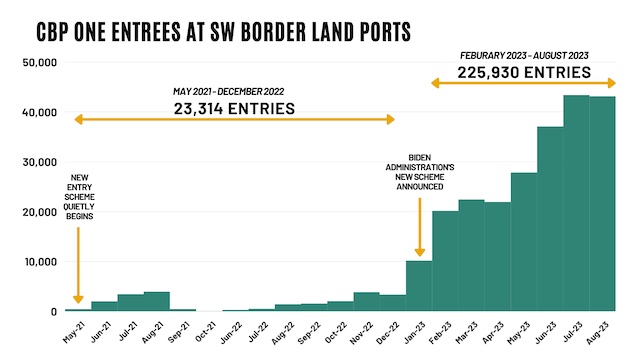Began far earlier and let in many more nationalities in far greater numbers than publicly disclosed

CBP One appointment recipients wait in long lines on the Matamoros, Mexico, side of an international bridge waiting to be called in by CBP officers on the Brownsville, Texas, side. May 2023 photo by Todd Bensman.
In January 2023, the Biden Administration announced what has become the cornerstone of its “new lawful pathways” strategy to manage the historic volumes of foreign nationals illegally crossing the U.S Southwest border.
The White House announcement explained that inadmissible aliens from four of the most numerous nationalities crossing illegally – Venezuelans, Nicaraguans, Haitians, and Cubans – would be able to use the “CBP One” mobile phone app to schedule an appointment with U.S. Customs and Border Protection (CBP) officers, in order to be escorted through a port of entry (POE) and quickly granted temporary “humanitarian parole” and released into the country.
Whether walking through a land port or flying in at government invitation, all such “paroled” immigrants are released on their own recognizance, signing an agreement to report to an Immigration and Customs Enforcement (ICE) office in their town of their choice and apply for two-year renewable work permits.
The purpose of this “lawful pathways” strategy was to reduce the number of illegal crossings by funneling inadmissible aliens “lawfully” through the ports of entry. It was developed to address the end of the pandemic-era Title 42 public health order that allowed DHS to rapidly expel migrants who had crossed the border illegally. The White House explained that the program was intended to “reduce the number of individuals crossing unlawfully between ports of entry.” The proposed regulation undergirding the strategy claimed that reducing illegal crossings by rechanneling border crossers into pre-authorized port entries would protect the migrants from smugglers and prevent “extreme overcrowding in border facilities.”
In the year since the administration switched to the “lawful pathways” strategy, Biden’s Department of Homeland Security (DHS) has offered little information on the total number, nationalities, and means of arrival (land or air) of individuals it has brought into the United States through this program.
It has defied requests for the data from the Center for Immigration Studies (CIS), members of Congress, and left-leaning migrant advocacy groups interested in knowing the totality, diversity, and mechanics of these scheduled paroles.
But CIS has obtained this data through Freedom of Information Act litigation. DHS’s uncharacteristically candid disclosures to CIS may have something to do with the fact that House Homeland Security Committee Chairman Mark Green (R-Tenn.) had apparently been seeking similar information, only in his case backed up by a subpoena threat.
 The data shows, in part, that nearly 250,000 foreign nationals through August 2023 have been paroled into the United States at the land border ports after scheduling crossing appointments with the CPB One mobile phone app. Of that total, only 136,000 came from Cuba, Haiti, Venezuela, and Nicaragua, the advertised beneficiaries; the rest, more than 100,000, came from a startlingly broad array of 93 other countries.
The data shows, in part, that nearly 250,000 foreign nationals through August 2023 have been paroled into the United States at the land border ports after scheduling crossing appointments with the CPB One mobile phone app. Of that total, only 136,000 came from Cuba, Haiti, Venezuela, and Nicaragua, the advertised beneficiaries; the rest, more than 100,000, came from a startlingly broad array of 93 other countries.
These numbers are in addition to some 221,000 whom the administration permitted to fly into U.S. airports (through mid-September) under a different parole program, as revealed in a previous CIS report from the same CIS FOIA litigation. (SEE “New Records Show Biden DHS Has Approved Hundreds of Thousands of Migrants for Secretive Foreign Flights Directly into U.S. Airports”.)
The records raise hard questions about those decisions.
“Special Interest Aliens”. For example, the Biden administration accepted foreign nationals from 24 nations designated by the U.S. government as being of national security concern because Islamic terrorist organizations operate in them. U.S. homeland security professionals have long tagged foreign nationals from such countries as “special interest aliens” (SIAs) – or in the current Biden administration parlance “special interest migrants” (SIMs) – regarding them as higher risks that warrant more security vetting. In the past, the government has been forced to contend with SIAs because they crossed illegally of their own volitions and got caught.
But in the case of these CBP-One programs, the government affirmatively chose to authorize their parole entries, distinguishing the act as an affirmative government choice.
Among those the government chose to parole in on CBP One app appointments were a smattering of “special Interest aliens” from Iran, Lebanon, Jordan, Egypt, Yemen, Indonesia, and even 154 Afghans.
Others the government approved to come in surprisingly high numbers despite their being from special interest nations were 3,852 Kyrgyzstanis, 1,843 Uzbekistanis, 780 Tajikistanis, and 339 Kazakhstanis, and 29 from Turkmenistan, not to mention many more from terror-plagued Africa countries such as Egypt, Senegal, and Mauritania.
Because these approved entrances have remained unknown to the American public, the Biden administration has not been questioned about whether it conducted enhanced security screening for these migrants (as was the practice with those caught crossing illegally) before affirming them for parole through ports.
Other records from the CIS FOIA litigation strongly suggest that whatever security vetting does occur may not be very thorough, because U.S. officials have approved 99.7 percent of all such applicants for parole, rejecting only 698 individuals out of hundreds of thousands. The government has withheld all information on the handful of rejections.
Mexicans? Russians? Perhaps most mysterious of the Biden administration’s CBP One decisions is bringing in through the land ports on humanitarian protection grounds more than 57,000 Mexican nationals, representing the largest single nationality in the program. This is clearly part of an unknown in-house program probably unrelated to any need for humanitarian intervention because Mexican citizens almost never qualify for U.S. protections and are rejected for asylum at a rate of 96 percent, so relatively few bother to apply.
 In other mysterious decisions that have never been questioned, Biden’s DHS paroled in at the land ports nearly 24,000 Russians, clearly a premediated war-related policy decision with potential diplomatic implications, but which drew little if any inquiry because few people have known about it.
In other mysterious decisions that have never been questioned, Biden’s DHS paroled in at the land ports nearly 24,000 Russians, clearly a premediated war-related policy decision with potential diplomatic implications, but which drew little if any inquiry because few people have known about it.
News of this unique American scheme allowing inadmissible aliens to schedule their illegal immigration has reached the farthest corners of the planet. The administration approved more than 1,086 Armenians, 888 from Belarus, 244 from Azerbaijan, and dozens from mainland China and Mongolia.
Inadmissible aliens from 21 African countries also walked over via CBP One, including people from South Africa, Togo, Gabon, Namibia, and Guinea-Bissau. Nationals from 13 countries of South America also entered, among them relatively untroubled nations such as Argentina, Chile, Ecuador, Bolivia, Suriname, and Guyana.
Some cases are so strange as to demand public explanation. Small numbers were let in from France, Spain, Greece, Poland, and Hungary, democracies not known as hotbeds of political persecution. One even came in from Canada, another from the United Kingdom and yet another from “British Indian Ocean Territory”. This is hard to explain given that many of these countries have visa waiver agreements with the United States and can enter at will through normal travel channels.
Birth of the Parole Machine. Beyond the data’s value in prompting questions about those approval decisions, the records show that the administration began secretively providing escorted CPB One entries-by-appointment through the border land ports a full 19 months before publicly unveiling a supercharged version of it to the American media in January 2023 as something brand new. It all began in May 2021. There weren’t many, by comparison with 2023. But by the time the administration announced its brand “new” CBP One parole scheme in January 2023, it had already quietly allowed 23,314 to enter without public acknowledgement.
It started with little publicity at a few border crossing towns such as Reynosa, Mexico, where CIS in November 2021 first stumbled upon and reported that an unusual new program of some sort was underway. (SEE “Inside a Most Unusual Mexican Migrant Camp”.)
This was long before the cell phone app was rolled out, and as CIS noted in yet another report about the CBP One program a year later, from inside the CBP One operation of a Mexicali, Mexico, non-government organizations were then helping a growing number of inadmissible aliens from a great many different countries, including special interest aliens, fill out all the CPB One desktop fields in coordination with Mexican and American officials on both sides. (See “Legalizing Border Crossing for All: The Next Stage of Biden’s Migration Crisis”.)
The new data shows that, in 2021, the administration paroled 10,303 inadmissible aliens from 29 countries, most of them from Mexico (3,798), Honduras (3,004), and Guatemala (1,366), who would ordinarily have been subject to Title 42 quick returns to Mexico.
 In 2022, the administration paroled over 13,011 inadmissible aliens from an expanded range of 35 nationalities as word spread around the globe, even if few Americans knew it existed.
In 2022, the administration paroled over 13,011 inadmissible aliens from an expanded range of 35 nationalities as word spread around the globe, even if few Americans knew it existed.
That year, 2022, one of several surprising new nationalities showed up and topped the list: more than 5,000 Russians, we now know, undoubtedly including some of the Chechens CIS encountered at a Muslims-only migrant shelter that opened in Tijuana in April 2022, which was helping them use the CBP One scheduling process. At the same shelter, CIS learned that volunteer staff were helping migrants from U.S.-designated countries of national security concern use the CBP One scheduling process, among them Uzbekistanis, Tajikistanis, and Afghans. (SEE “Mexico’s First Muslim Immigrant Shelter: A U.S. National Security Perspective””.) But CBP never responded to CIS phone and email inquiries about this unreported program.
As 2023 was approaching, Biden administration officials must have seen that a streamlined, scaled-up version of the parole program might forestall bad political optics if U.S. intelligence community predictions came true that the biggest numbers of migrants yet would illegally flood the U.S. borderlands after the May 12 end of Title 42. Fewer migrants, however, would be seen or counted as illegal crossers if they were instead channeled, under color of law, through the less visible international bridges and port buildings out of sight of news camera drones.
That’s when the administration announced in January 2023 that it would streamline CBP One parole process, and hugely expand use of parole.
Written by Todd Bensman for Center for Immigration Studies ~ October 24, 2023
